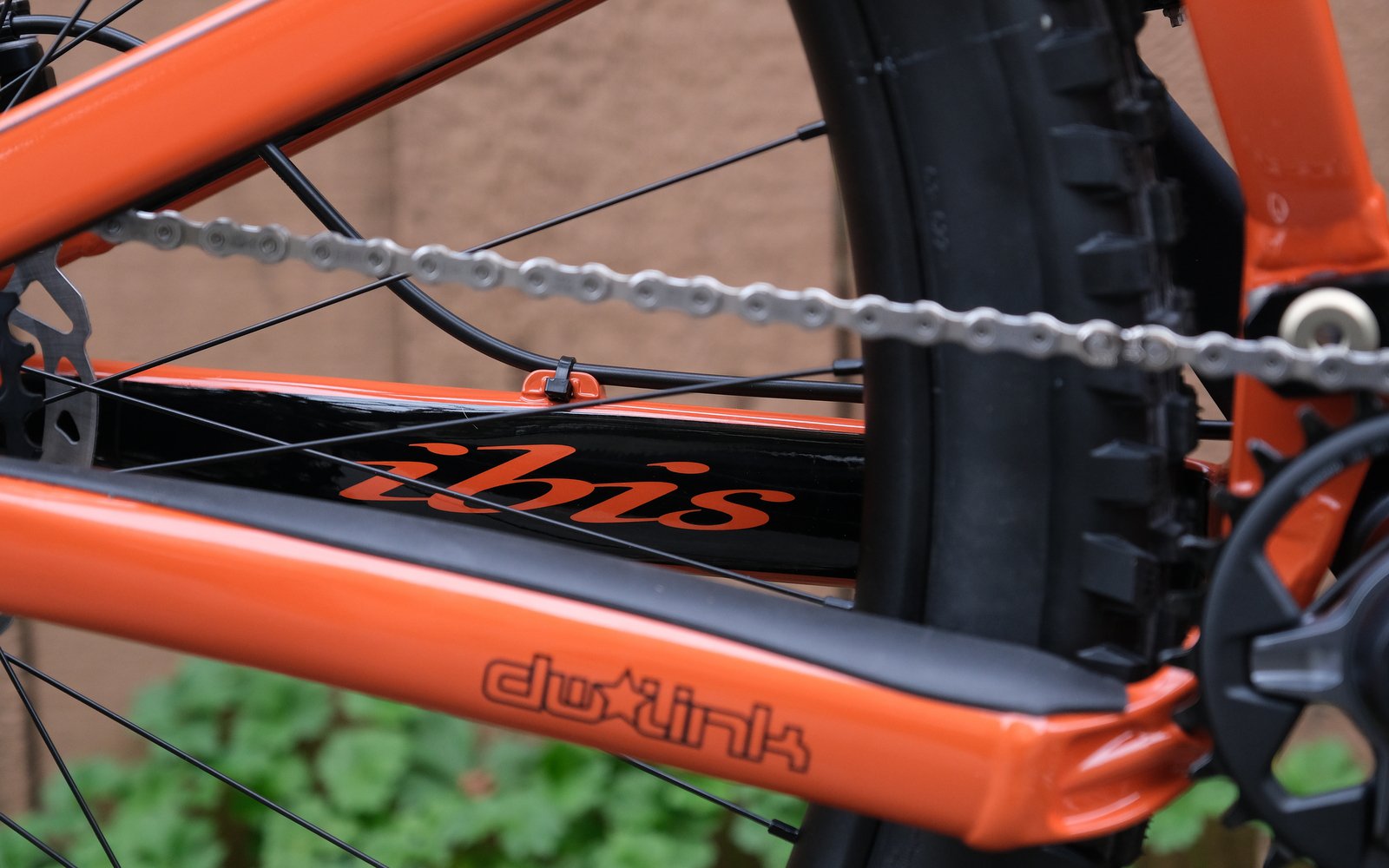
FIRST IMPRESSIONS REVIEW
2021 Ibis Ripmo AF - First Look
It's impossible for me to talk about the Ripmo AF without referencing the Ripley that I tested a little while back. To summarize all of those words into one sentence, it climbed like the dickens, was a blast to ride down a hill, but beat me up pretty bad in the process. An oft repeated thought was "if only it had more travel!" Which, I hope you all take as the compliment it is. There are only a few 130/120mm bikes that will allow you to ride down a trail at the sort of pace that the Ripley allows.
I did have thoughts through that test about how I could sculpt the Ripley to better suit the riding I typically do. Most of these ideas were some permutation of jamming a bigger fork onto the front, but I had a few other thoughts about what I would do if I wanted to make it easier to ride downhill. As I presented those ideas to Ibis they had a fairly consistent response for me: Get a Ripmo. So I did.
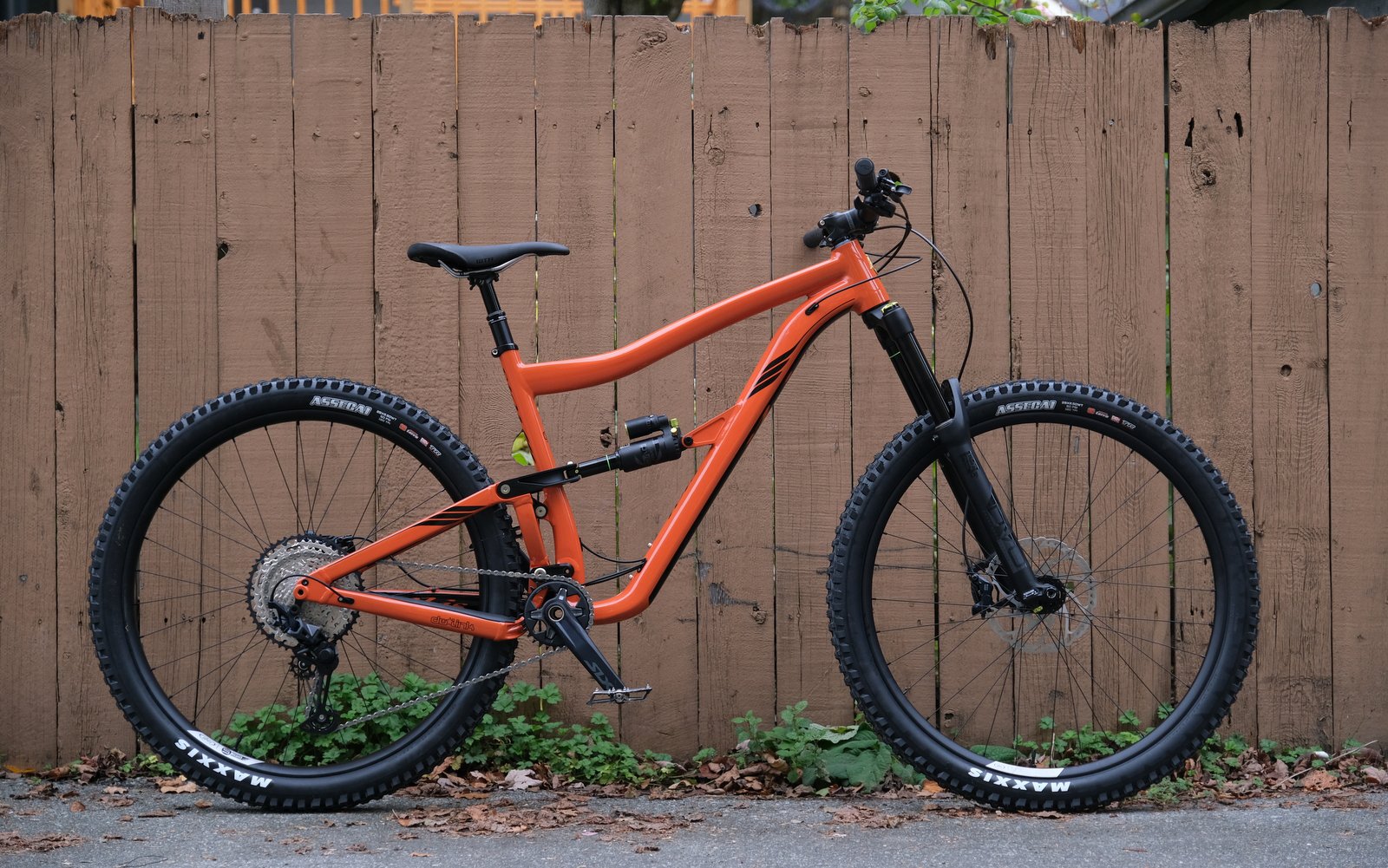
To my eyes, it looks larger than it is. But then again, it is an XL 29er.
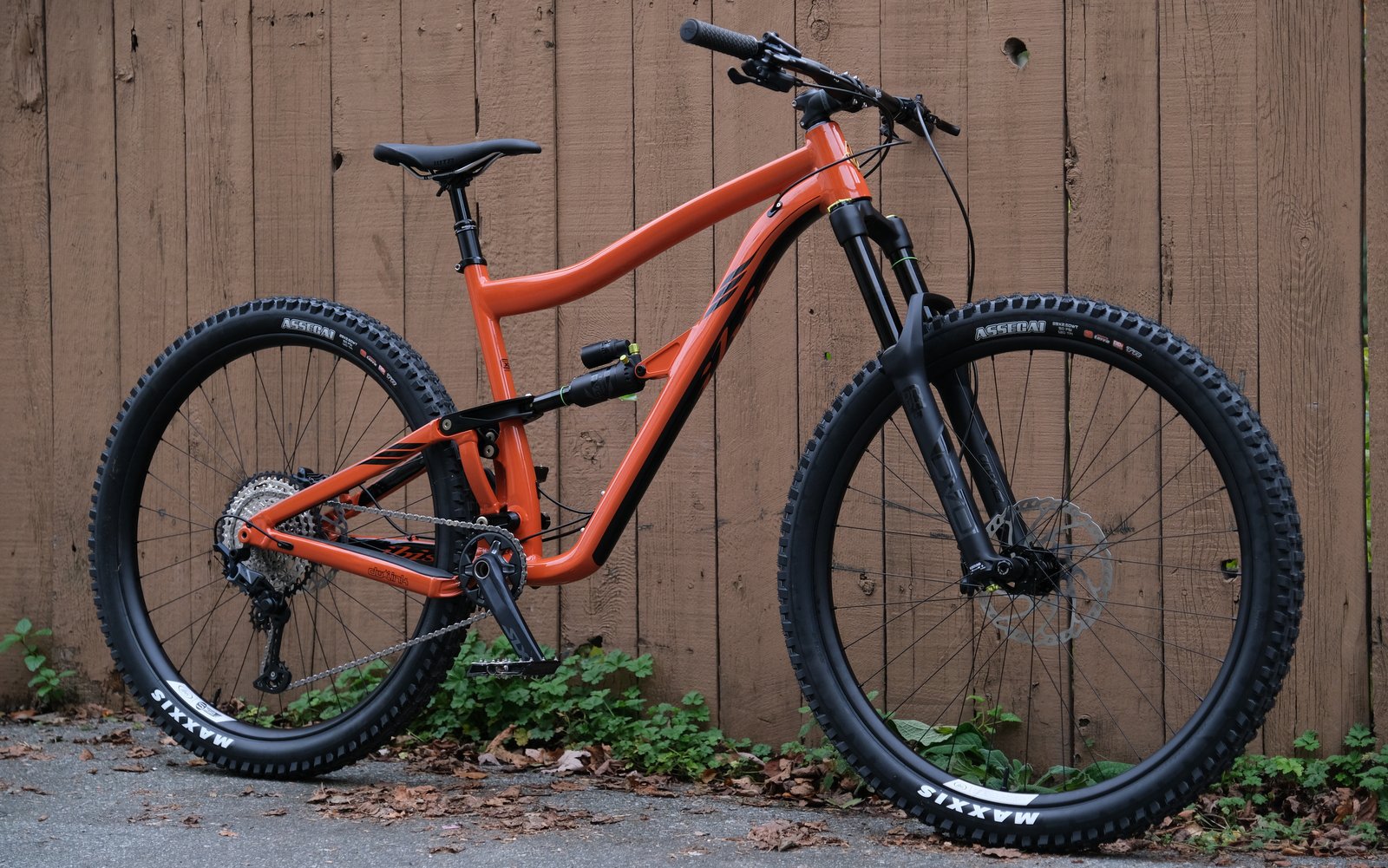
This angle is a bit kinder.
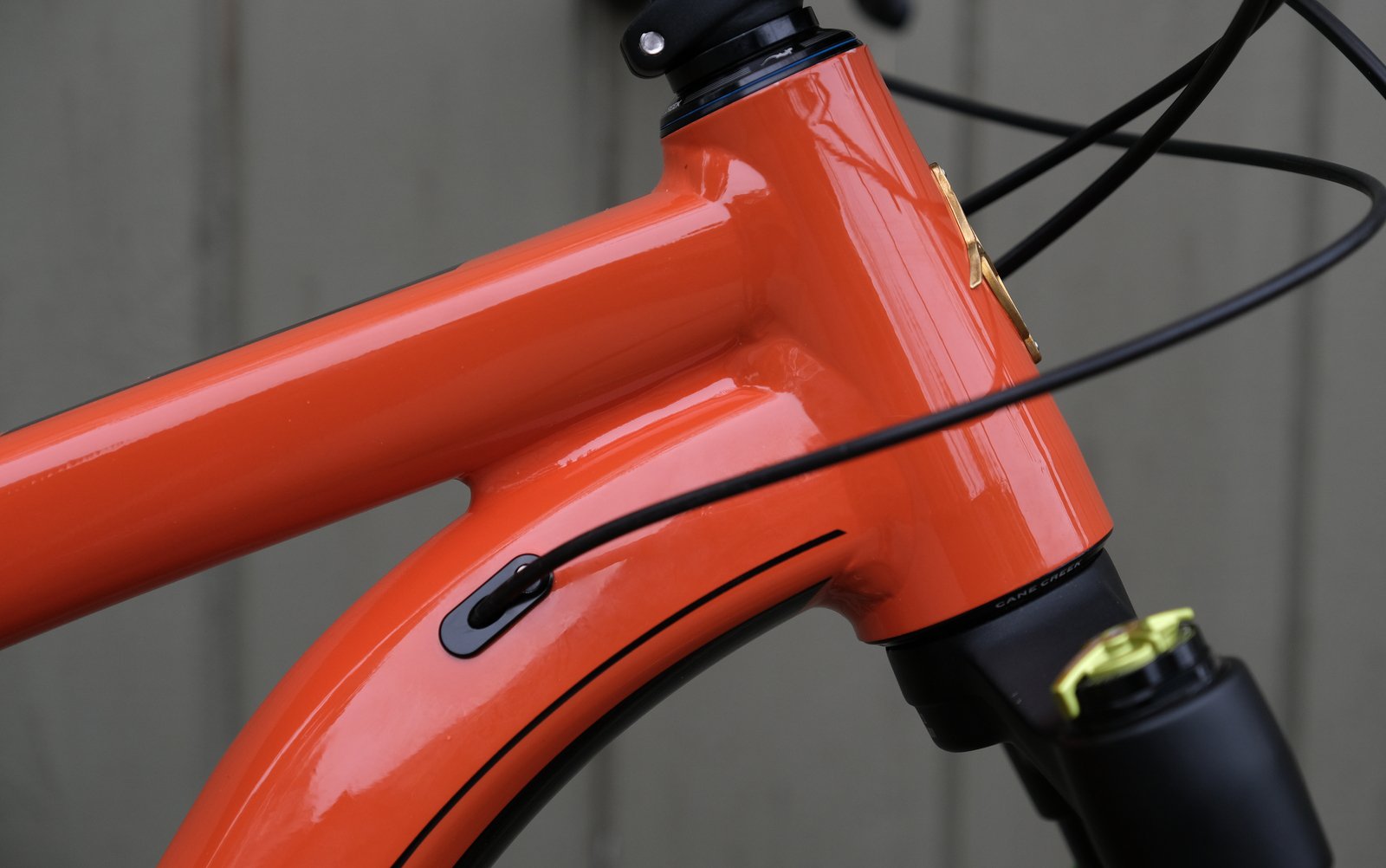
Burly and well put together would be a good theme.
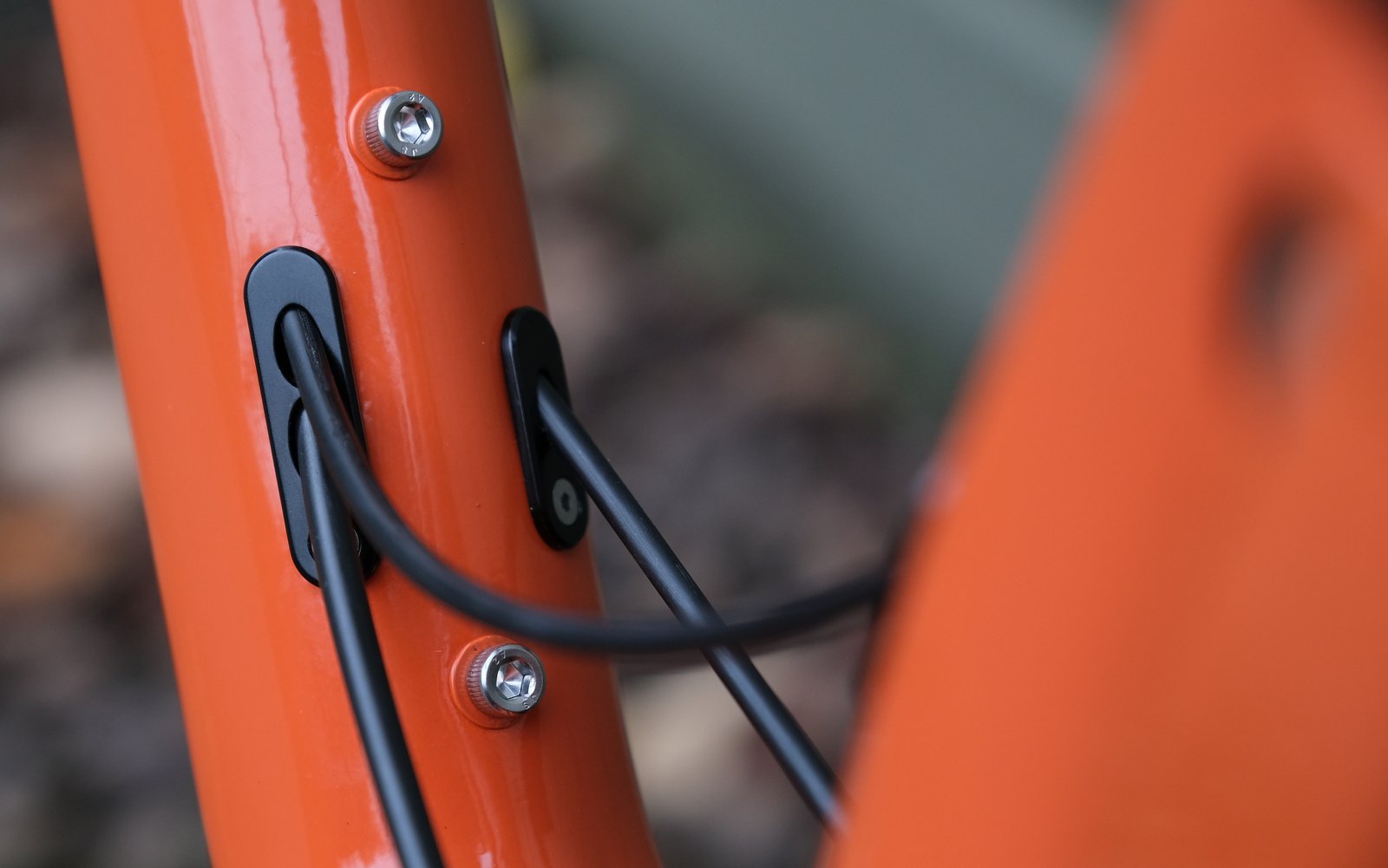
The lower portion of the bike is fairly busy.
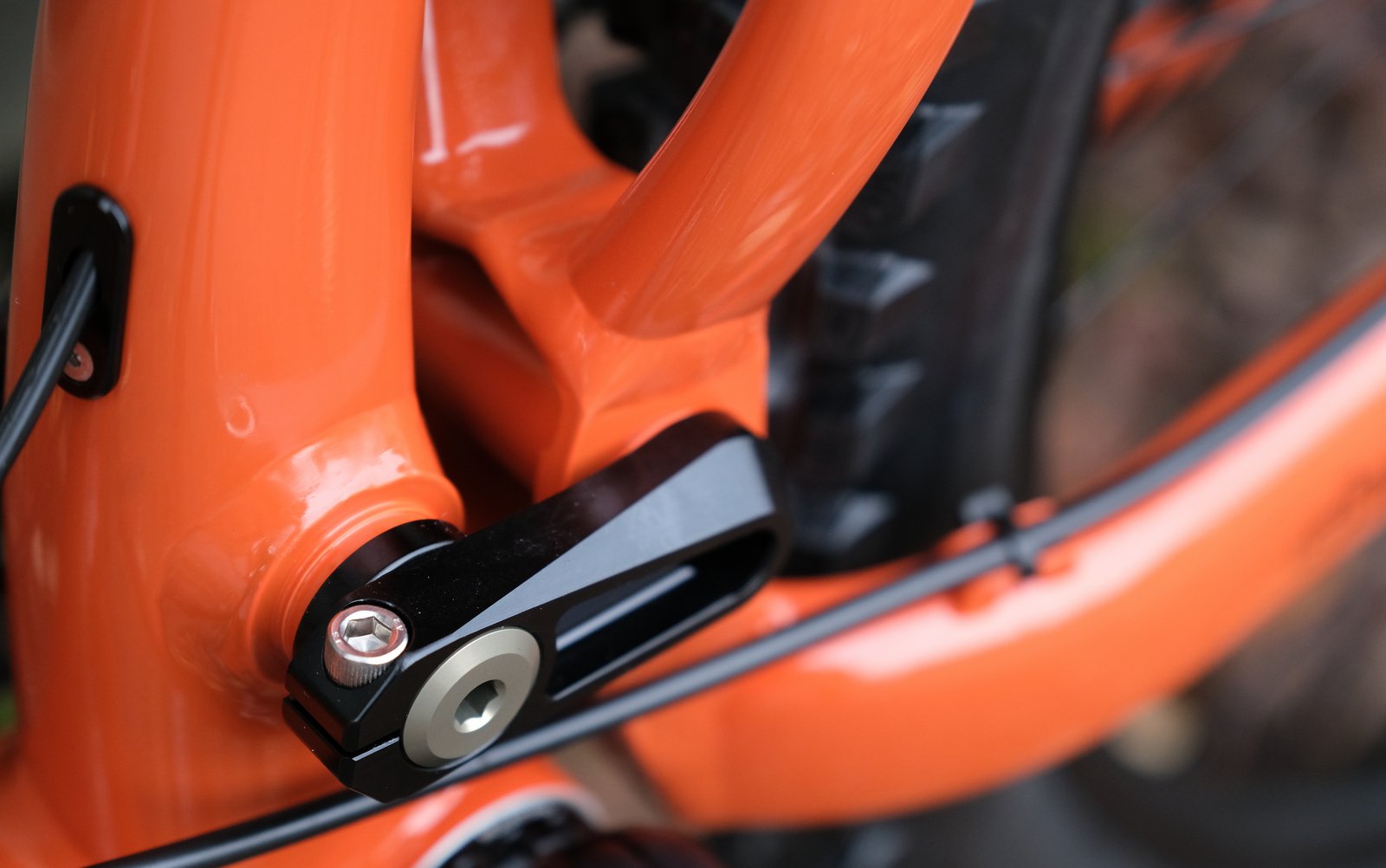
Look at this junction! This deserves more attention.
The Ripmo AF Frame
Ibis offers the Ripmo in two separate versions. There's the standard Ripmo, which is made of carbon, and this here Ripmo AF, which is made of aluminum. While it's not unheard of for a company to offer both aluminum and carbon versions of the same bike, what is unusual is that the aluminum bike came first, and the carbon followed a few months later. The bikes share suspension kinematics and most of their geometry (there's a few minor differences if you put the two geo charts side-by-side), but the biggest difference is the material, some weight and quite a few dollars. For some strange reason I found myself more excited to see what the decidedly lower cost aluminum version was all about.
The aluminum frame is a bit of a trip, for sure. In these days of swoopy carbon it gives off a bit of a mid-school vibe with its frumpy aluminum tubes. The geometry and stance is all fairly current, but those aluminum tubes bend the mind a little bit. Especially in the XL version, the front triangle looks a bit larger than it is, and the whole thing combines into a package that is a little bit Jason Segel (you wonder why they hired a 30-year-old to play a high school kid and then you're shocked when you realize he was 19 all along).
Digging into that geometry: while "current" it certainly isn't the longest or slackest. The head angle is a whisper under 65 degrees, and the reach on the XL is a smidge under 500mm. Couple that with a 76-degree seat angle, and a head tube/stack height that isn't all that high, and you get a bike that is in the middle of the spectrum for its intended size. I'll sometimes debate an L vs. XL, but it's an easy call to go larger with this bike.
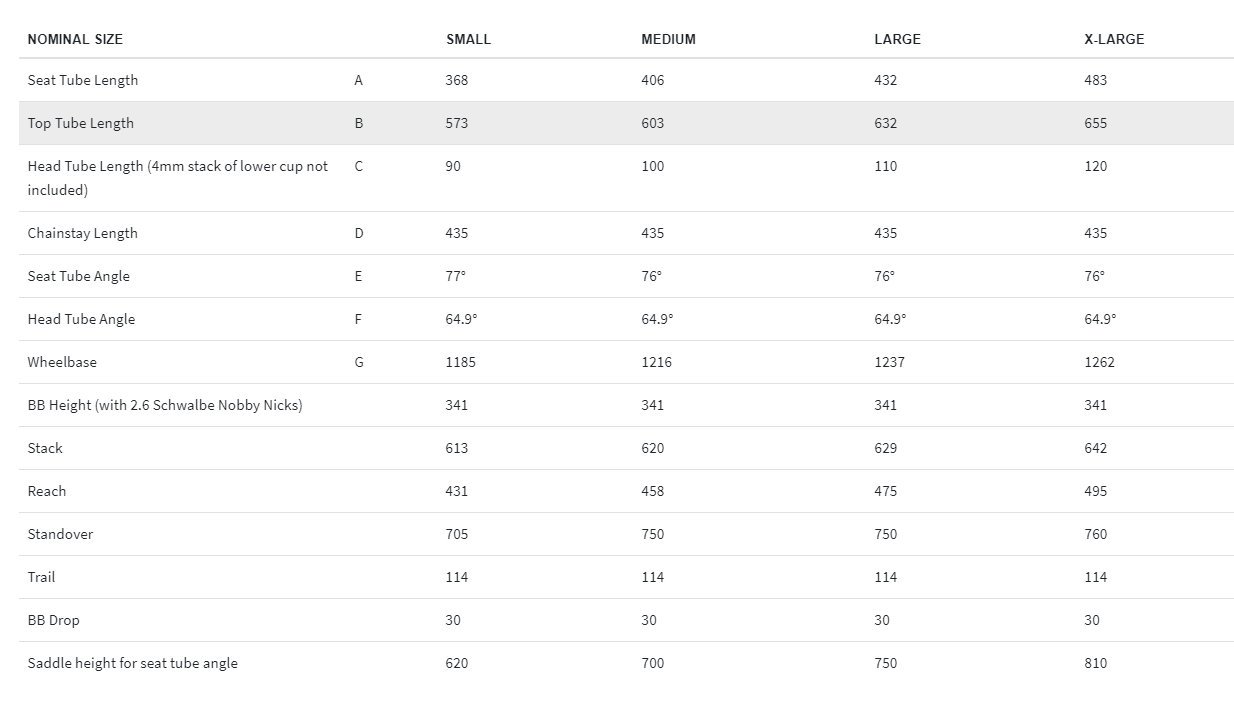
The frame itself looks fairly solid. I'm continually surprised bike companies are able to bang out these incredibly complex aluminum constructions with little to no fanfare. We take it for granted that these people can now make whatever the hell they want out of aluminum. The rear end is a really intricate piece, and I think shows the amount of thought and design that goes into a bike like this. All in all it feels like a solid, well-constructed frame and that you're getting value for your money.
Highlights
- 160mm front travel and 147mm rear
- Aluminum frame
- 29" wheels and up to 2.6" tires
- DW Link Suspension
- 64.9º Head Angle
- DVO Fork and Rear Shock
The Suspension
The Ripmo AF uses a DW-Link rear end. The folks over at Pinkbike were kind enough to post a full breakdown of the kinematics of this bike, and I'm certainly not going to sneeze at all of that effort. If you want to read a few thousand words on that, fly at it. If you don't, I'll do my best to interpret.
Progression - There's a fair amount of progression baked in to the rear end of this bike, however most of it comes in the first part of travel. It's a steeply progressive ratio until you get to the sag point, where the curve flattens out a bit, before ramping up a smidge at the end of travel. What that means is that it's going to ride a bit softer than the 20% progression number suggests.
Anti-Squat - The Ripmo twins have a fair amount of anti-squat, consistently through full travel. DW-Linked bikes have a reputation for pedalling well, and you would expect the same of this bike from looking at these numbers.
Combine these two things and it adds up to a bike that is going to have a firm pedaling platform, but that won't hesitate to use all available travel. It certainly doesn't look like something that screams out for a coil shock, but it is an option that Ibis makes available. We'll see if we can figure out a way to track one down to throw into the mix. Which leads nicely to us talking about the rear shock on this bike.
The DVO Topaz is not a common spec choice. DVO is a smaller company than the big two, but comes with a pedigree of making well built, tunable and re-buildable suspension components. As luck would have it, one of the main guys at DVO has a Ripmo as his personal bike so he was able to provide a few tuning suggestions, over and above the fairly thorough Ibis tuning guide (and the also fairly thorough Jade tuning guide). The basics of that advice were to take a spacer out of the negative chamber to provide a bit more suppleness off the bottom, and to add a bunch more air pressure. My happy place proved to be somewhere around halfway between these two (three!) sets of recommendations, and I wound up at around 27% sag. From the DVO suggestions, I liked the increased negative spring volume, but preferred the ride with a the air pressure dialled back a bit towards the lower Ibis numbers. I also popped the negative chamber spacer that I removed over into the positive chamber, for a bit more ramp up in the shock. This gives me a rear end that does fairly easily use all available travel, but feels pretty good while doing it.
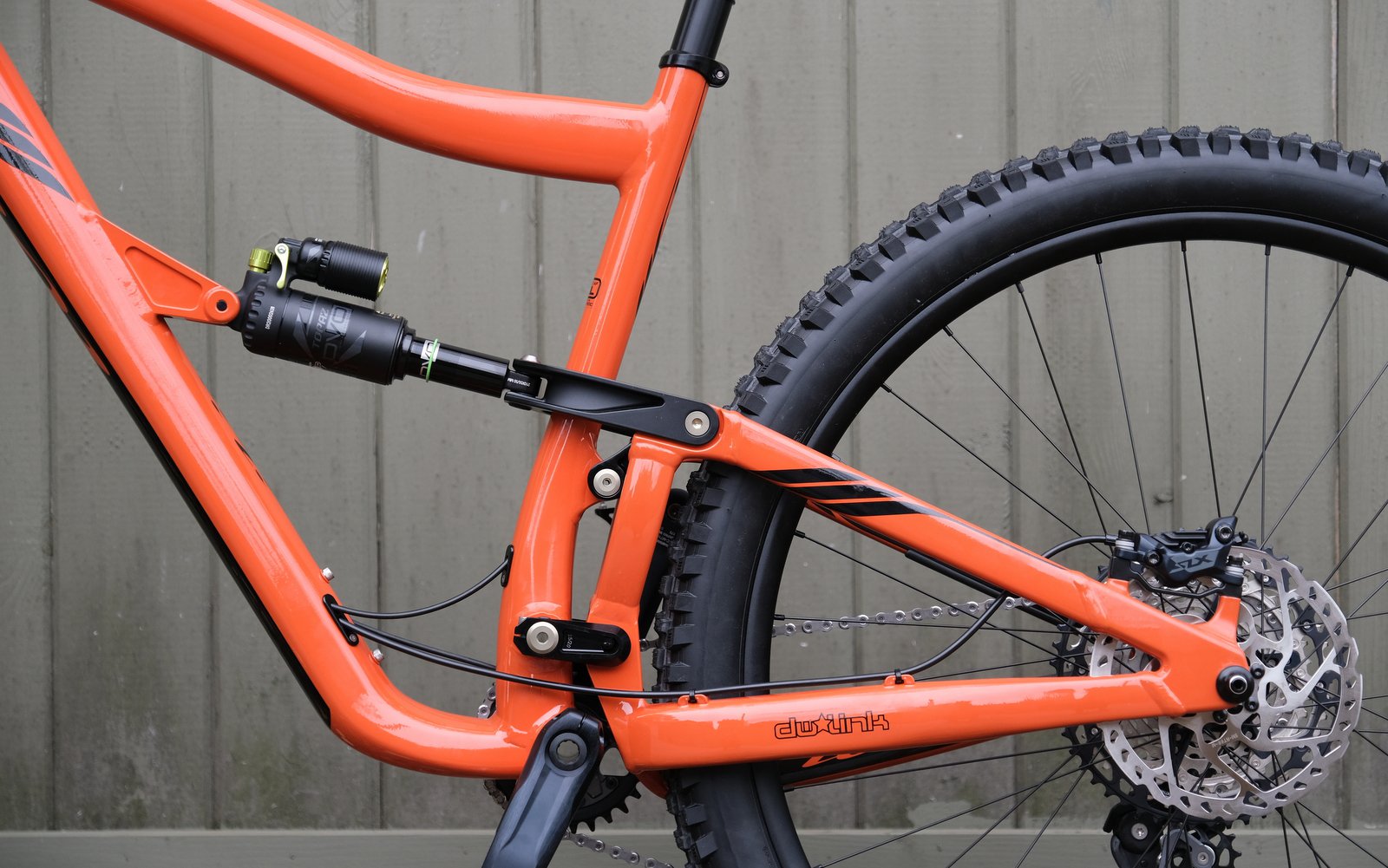
There is a lot of family familiarity among Ibis models.
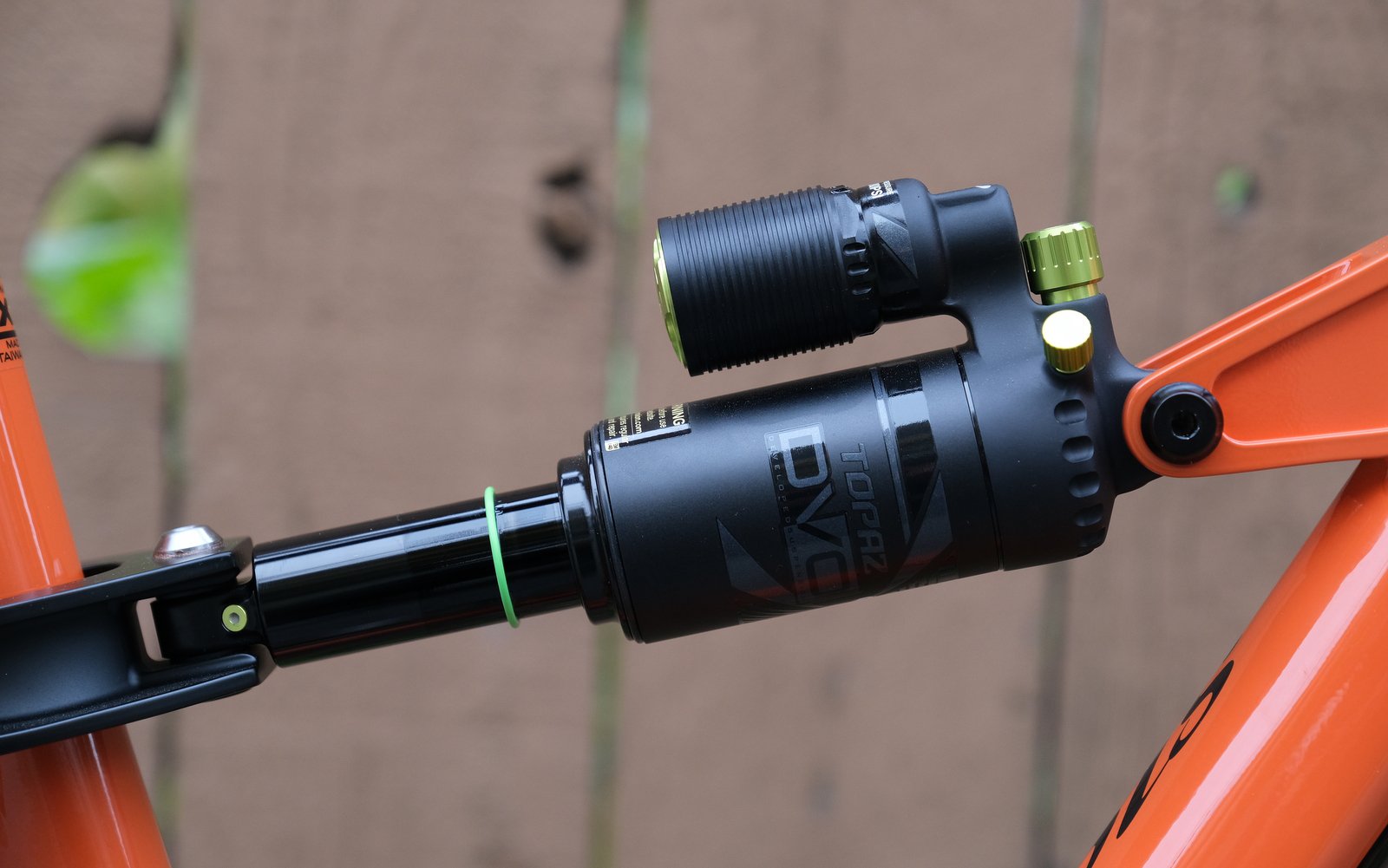
The Topaz rear shock.
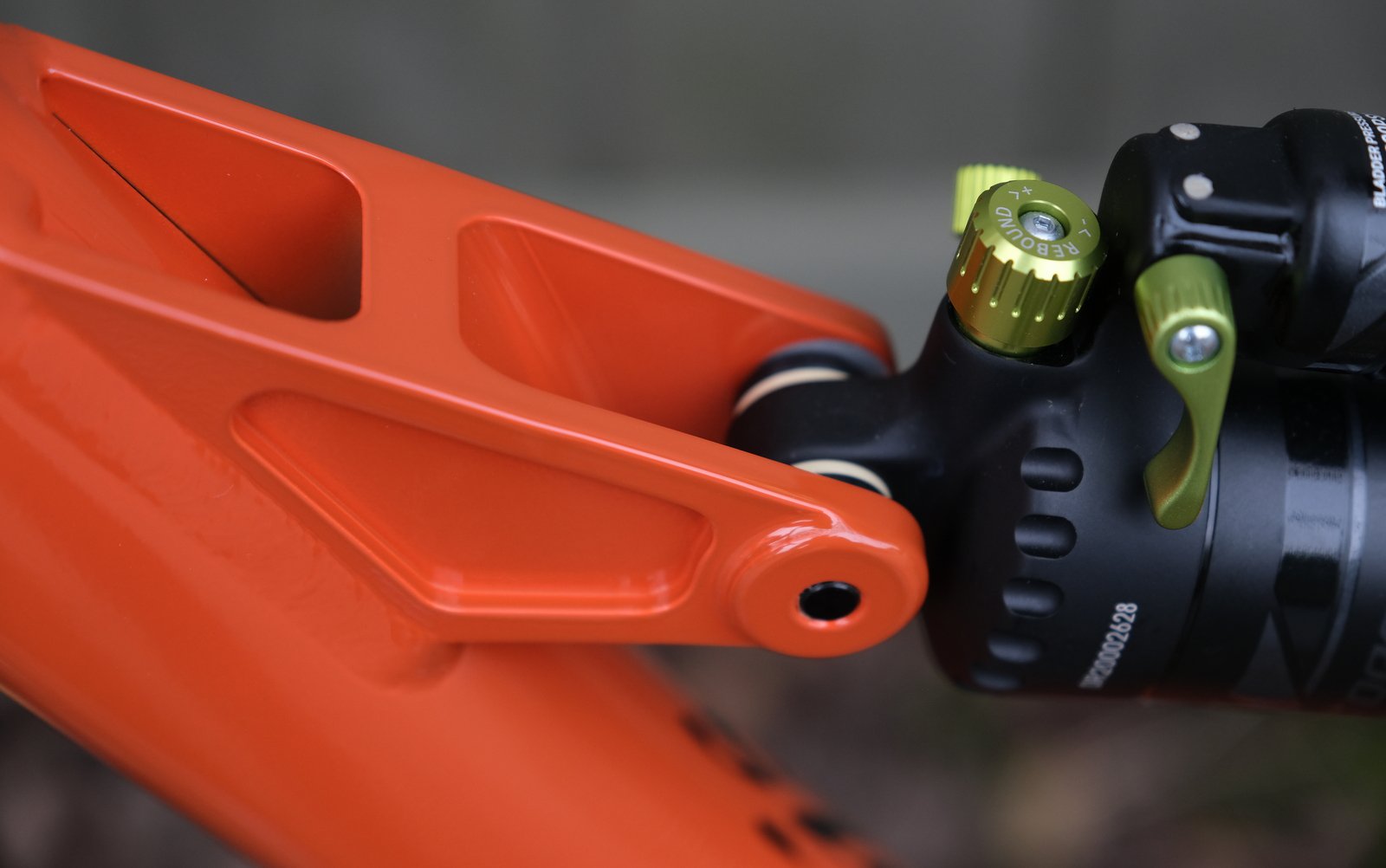
A solid shock mount.
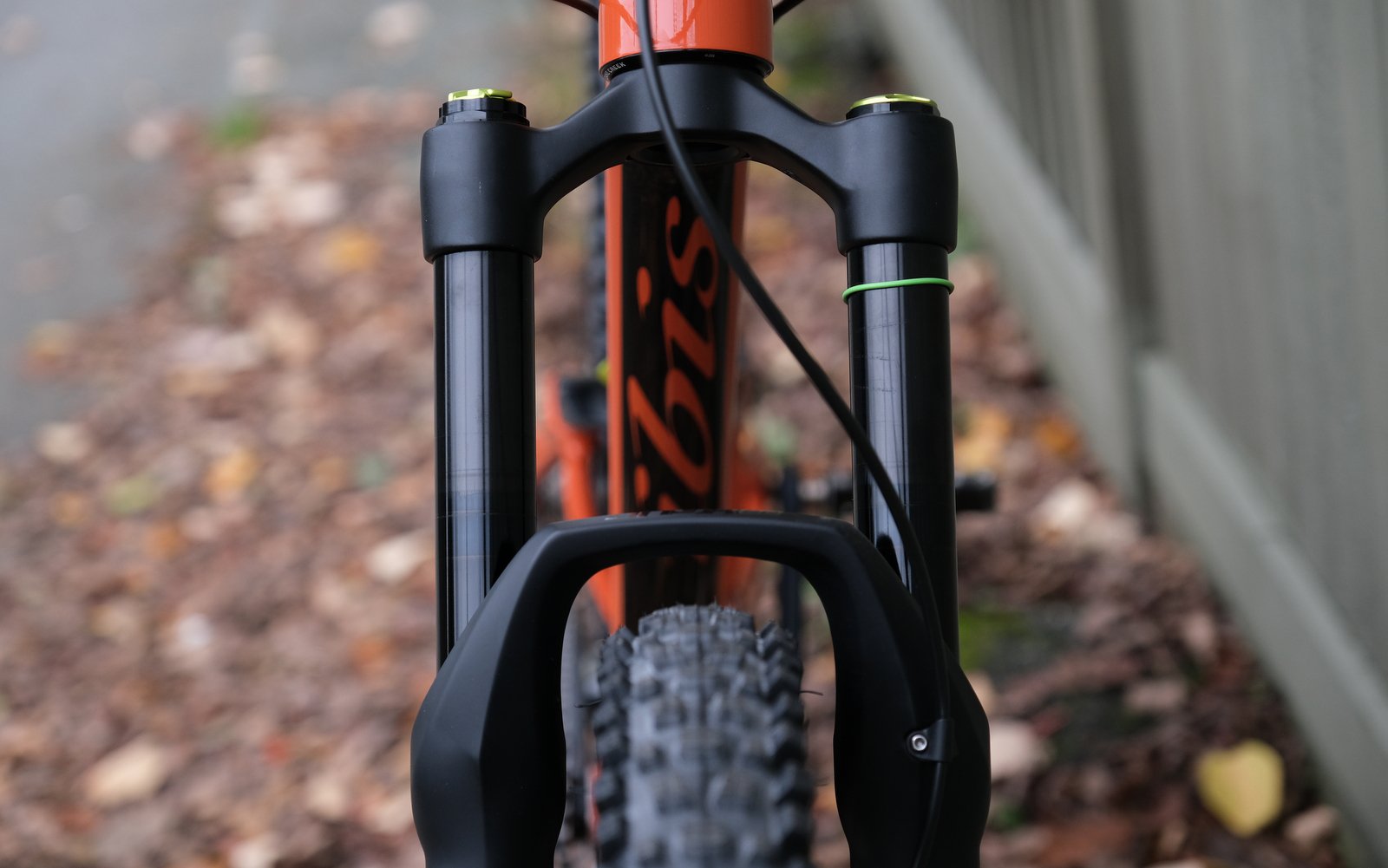
Lots of tire clearance on the Onyx.
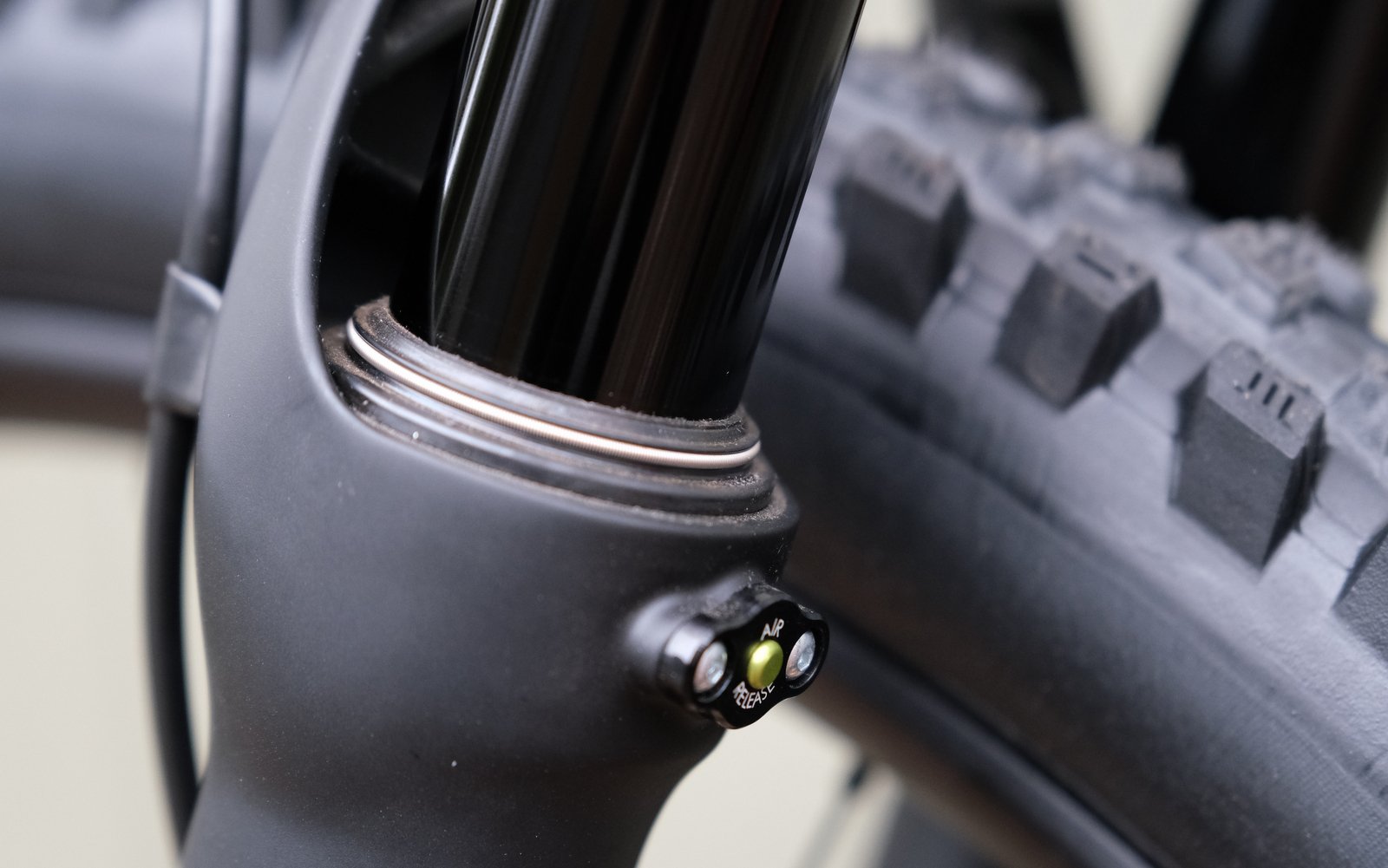
Buttons to push, if that's your jam.
The Onyx D1 fork also comes from DVO, and it's pretty freaking nice. It's a 36mm stanchion fork that is akin to what the 36/Lyrik were before the 38/Zeb showed up (160-180mm of travel). It has most of the features you would find on a higher end Fox/RockShox (HSC, LSC, rebound, fork bleed nipples, integrated fender) and a few that you won't (adjustable coil negative spring, compression bladder-based damping). It definitely is a change from what is on the front of most bikes.
Tuning a DVO fork is a bit different than with other forks, but I find it to be intuitive and easy to arrive at something that feels and rides well. Start at the recommended pressure and adjust up or down to get your preferred mid stroke/end stroke, then use the OTT (adjustable coil negative spring) to dial in how soft you want your initial stroke. It lacks the volume spacer system used by many, but I find their system makes it easy and quick to get to a place where I'm happy, and I'm confident in the results when I get there. This might not be the case for all, but if you're a way heavier or way lighter rider, or just want something totally different, DVO will offer you custom tuning for $100. And, check out their small parts catalogue! Ya, you can probably buy all the same stuff for your Fox/Rock Shox fork too, but not this easily. While we're at it, Ibis has a pretty great parts selection available, too. If I owned this bike I would be so, so, so happy that I could order up a full rebuild kit without relying on the whims of a shop employee.
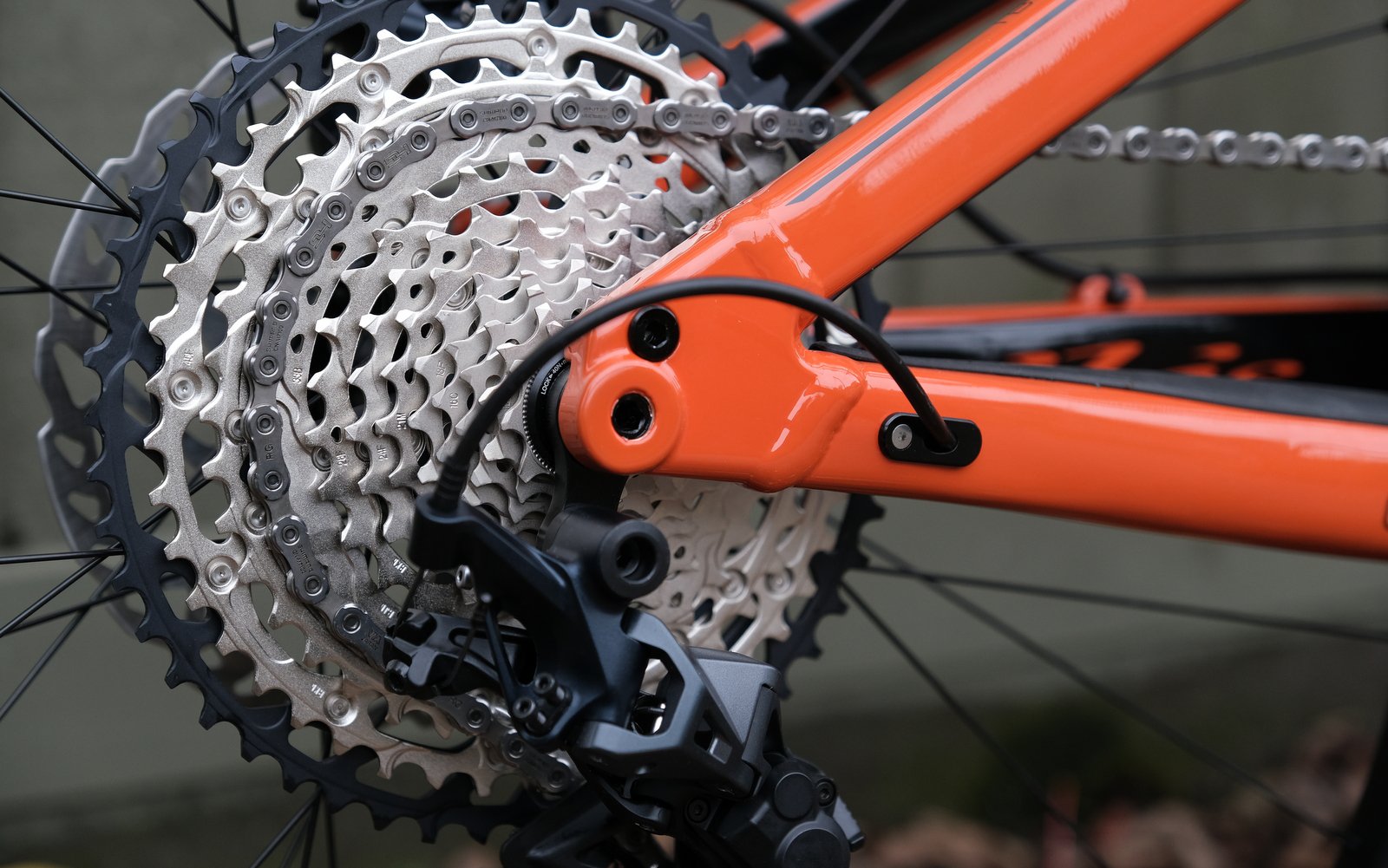
I won't talk about this much here, but the new SLX stuff is pretty fantastic.
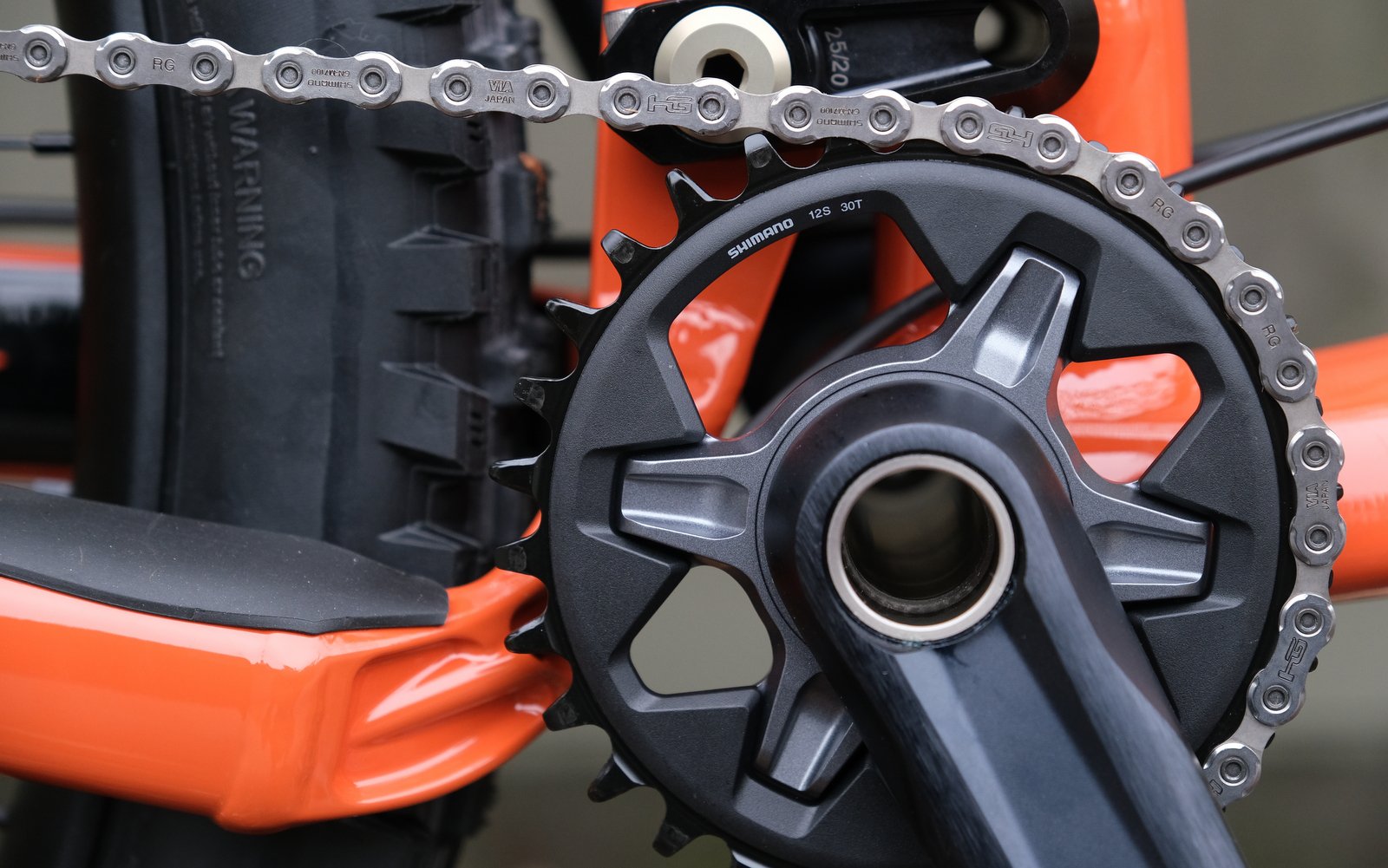
I'll take this 30t over on the Norco Shore, please!
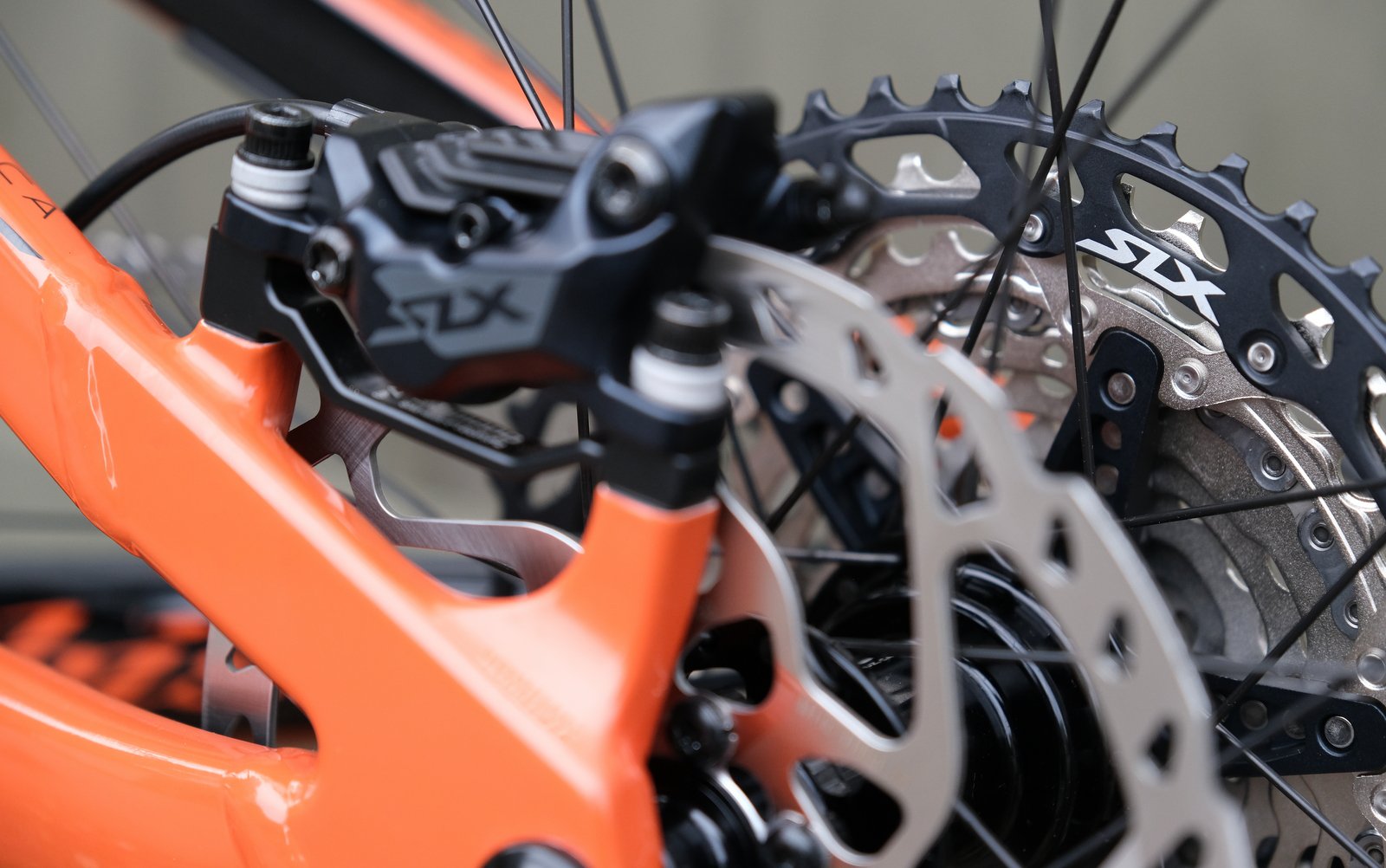
Remember how bad cassettes that were anything less than XT level used to look?
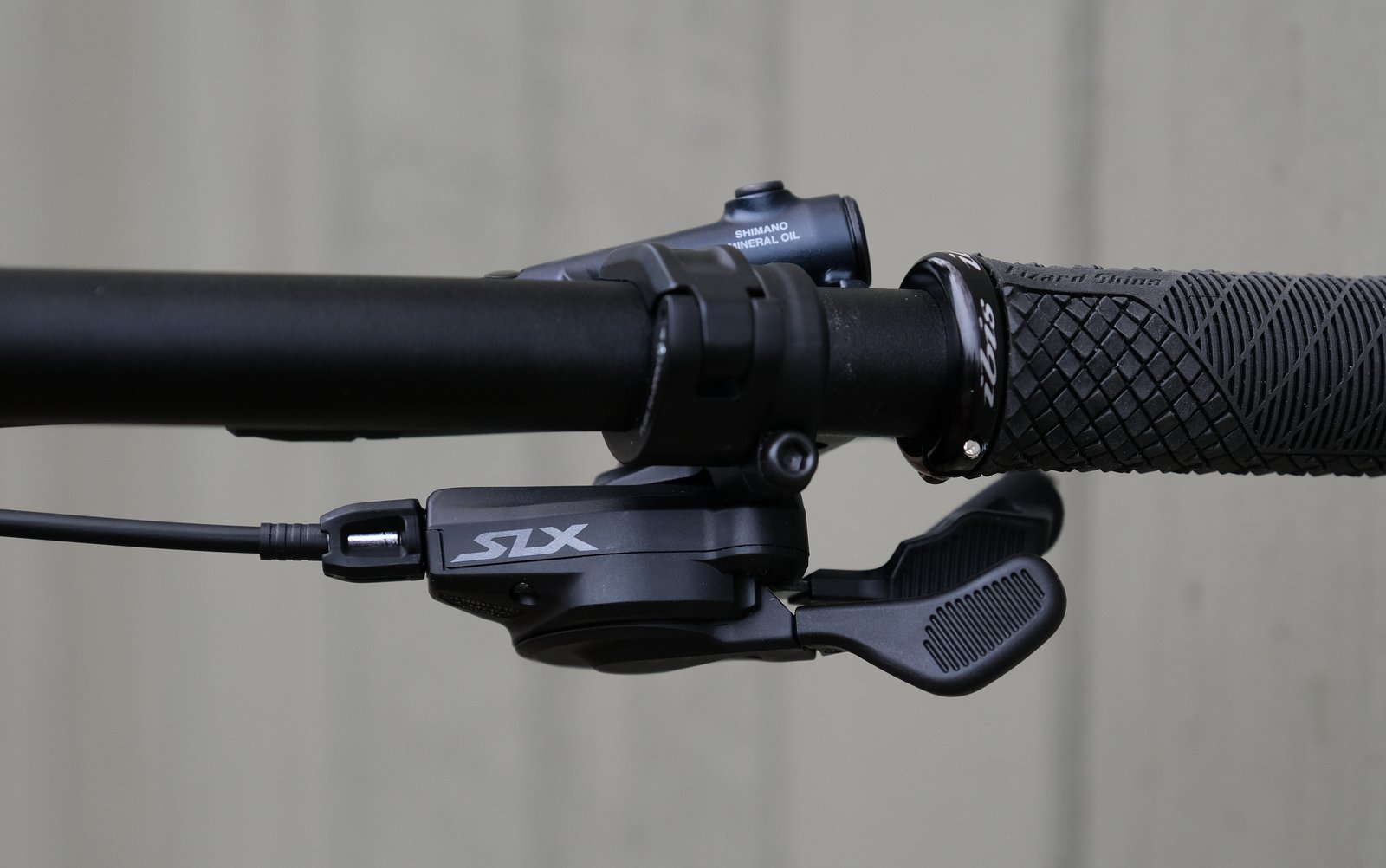
Shimano should put some energy into making their shifters look (and feel) nicer.
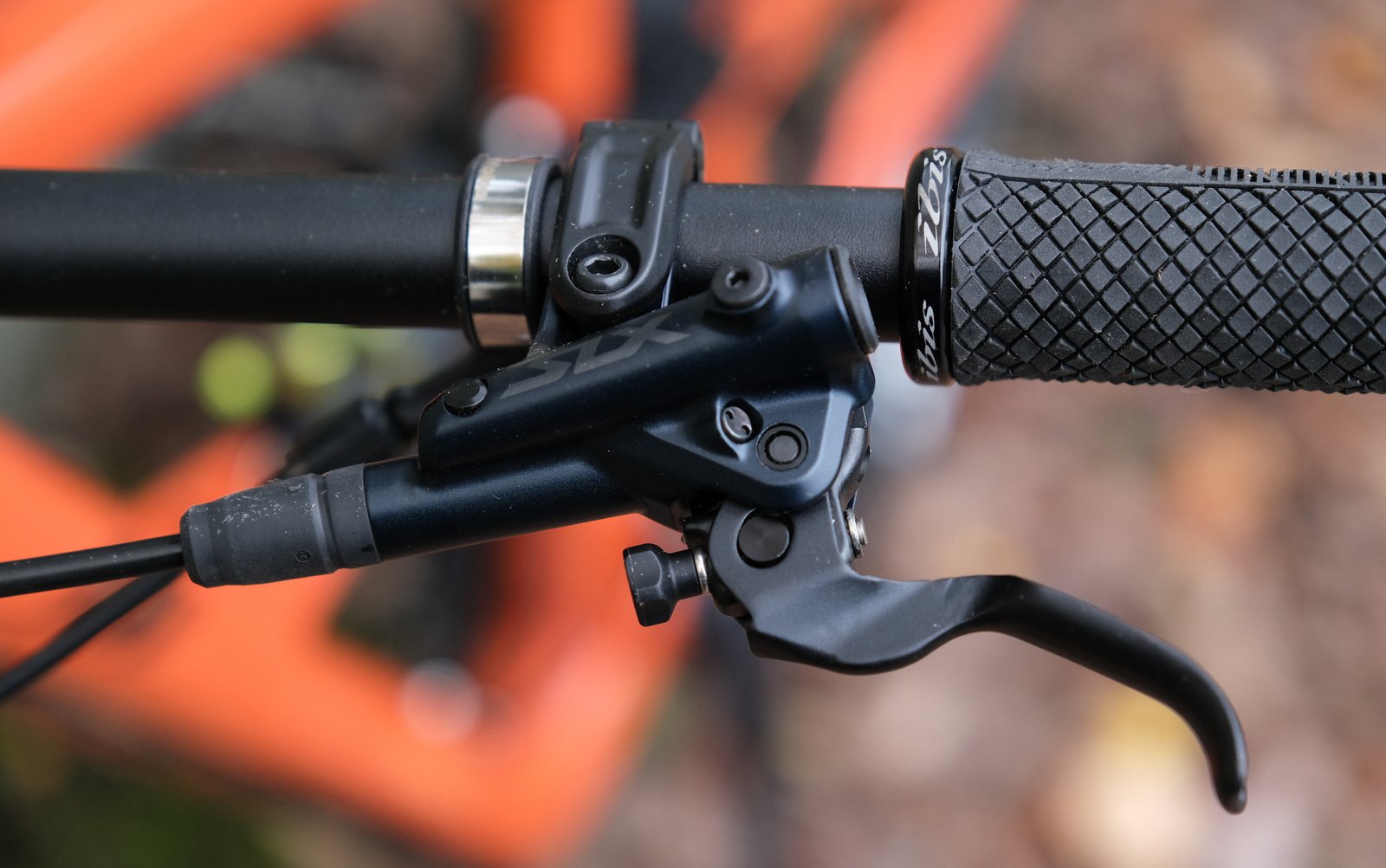
This is a shot of the brake lever, but I've really come to love these Lizard Skins grips.
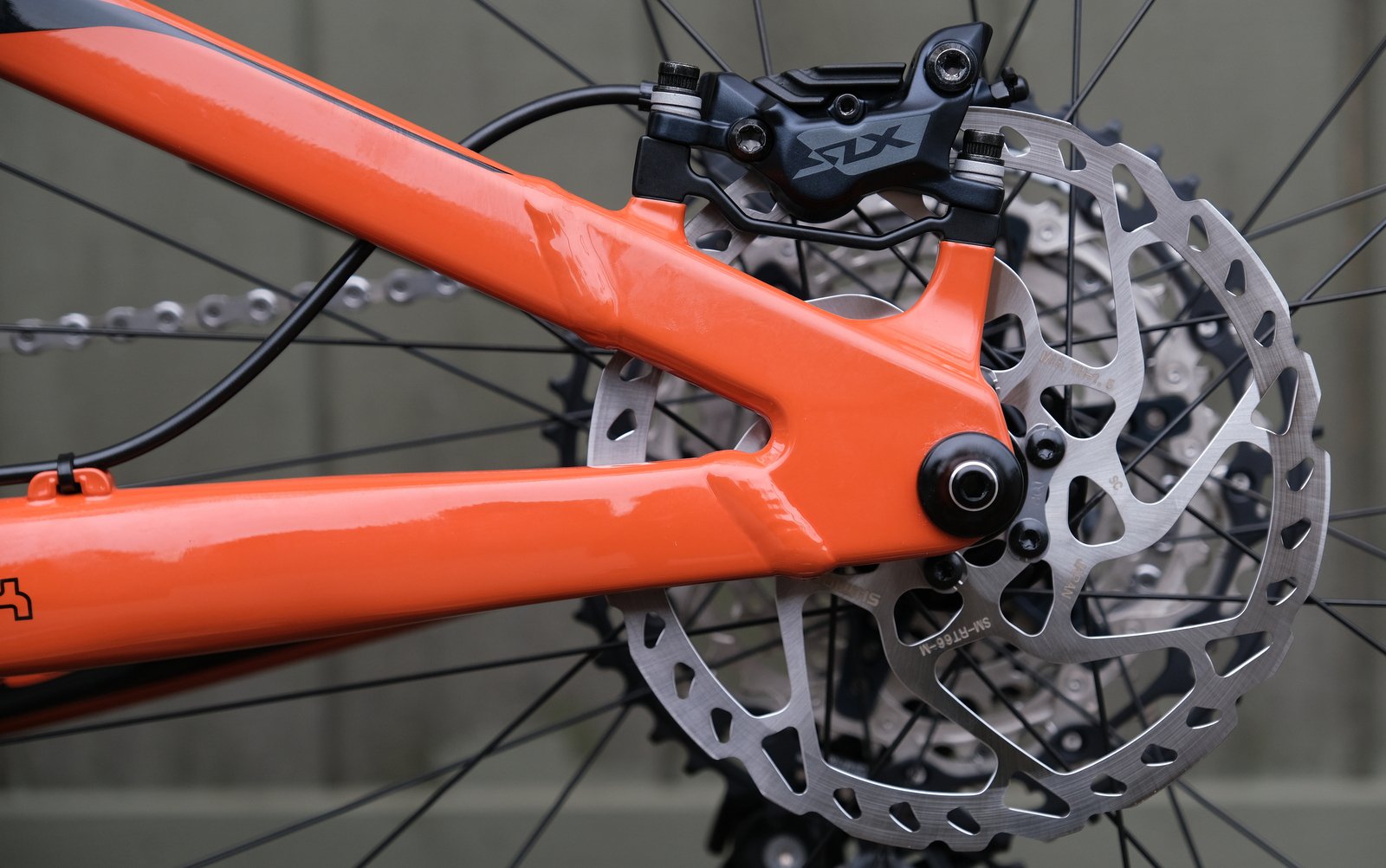
Basic rotors, but they get the job done.
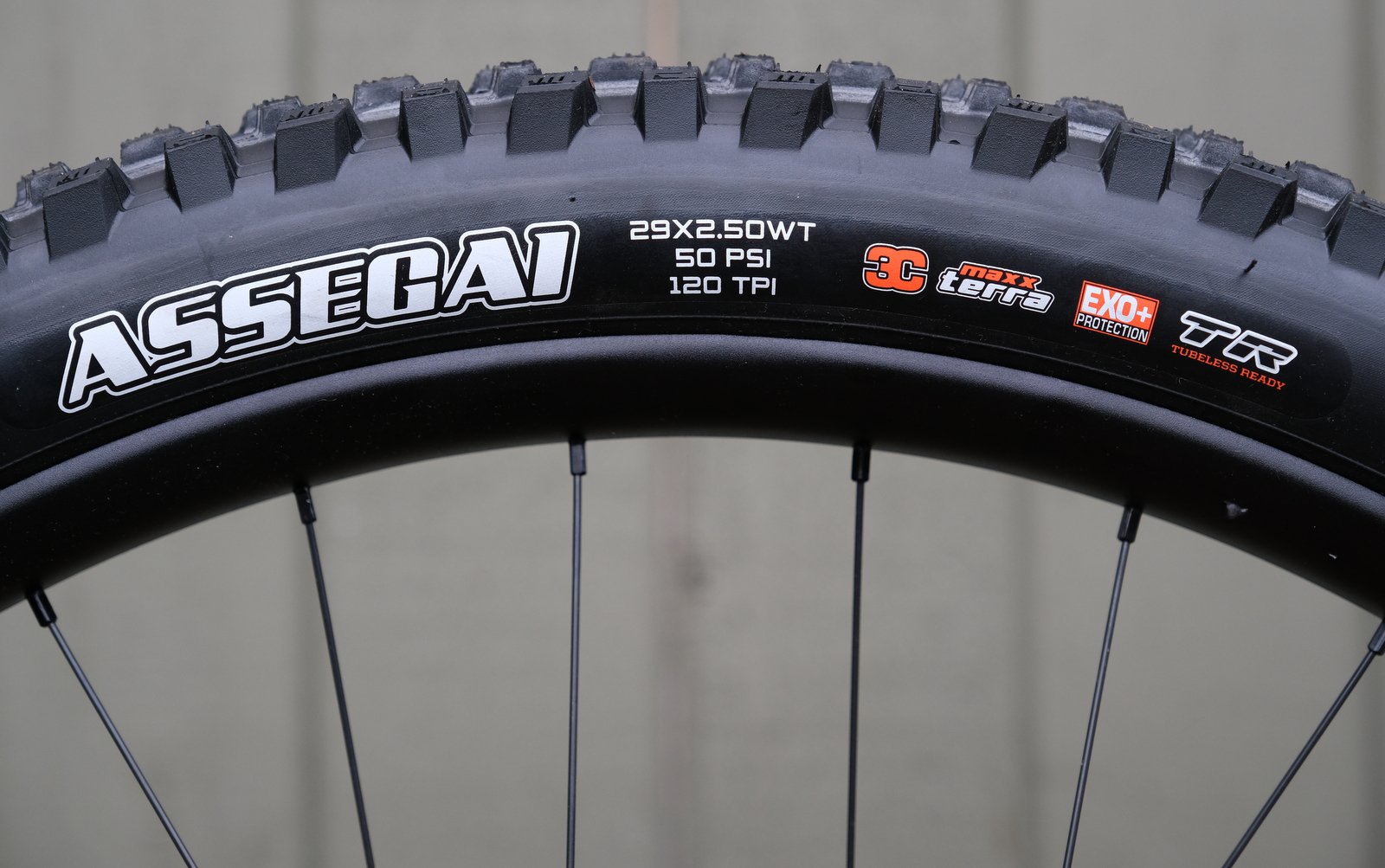
Not too shabby!
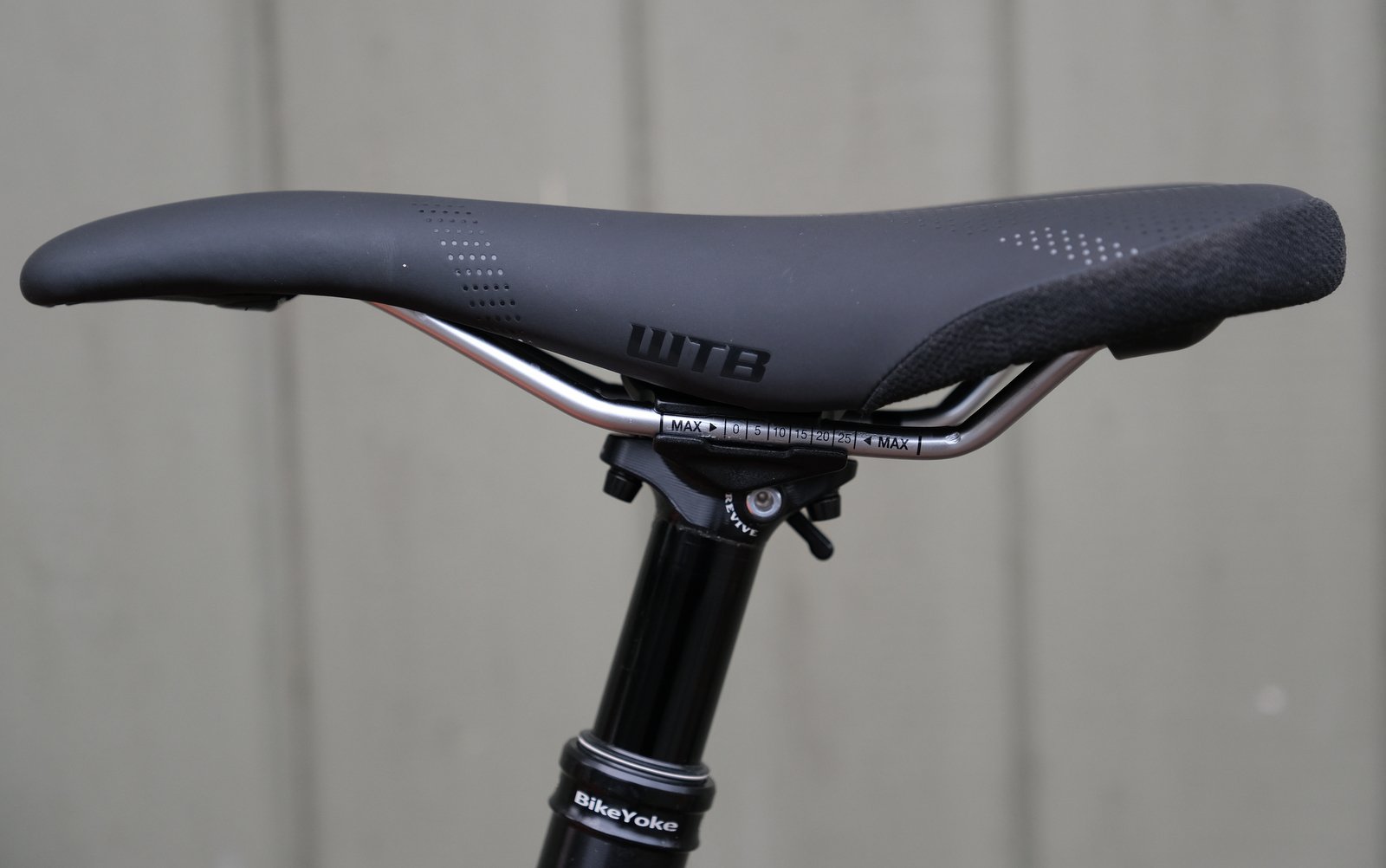
The WTB saddle and the Bike Yoke dropper are a particularly nice touch at this price point.
The Parts
The rest of the parts choices are far more conventional than the suspension bits. First off, there's a full SLX drivetrain, as well as 4-piston brakes, with no hidden downgrades anywhere.
Next, you'll probably notice the Ibis wheels, which use their S35 aluminum rims mated to a pair of Ibis-branded hubs. Wrapped around those rims are Maxxis Assegai 2.5s in an EXO+ casing and MaxxTerra rubber.
The final bits and bobs are from Bike Yoke (185mm dropper and matching lever), Cane Creek (headset), WTB (Silverado saddle), Lizard Skins (grips) and a few more Ibis doodads (aluminum stem and handlebar).
There's nothing fancy here, except maybe the post, but absolutely nothing to complain about either. Somebody will probably complain about the casing or the rubber spec, but if Assegai EXO+ is where we're at in tire spec these days, I'm a pretty happy camper.
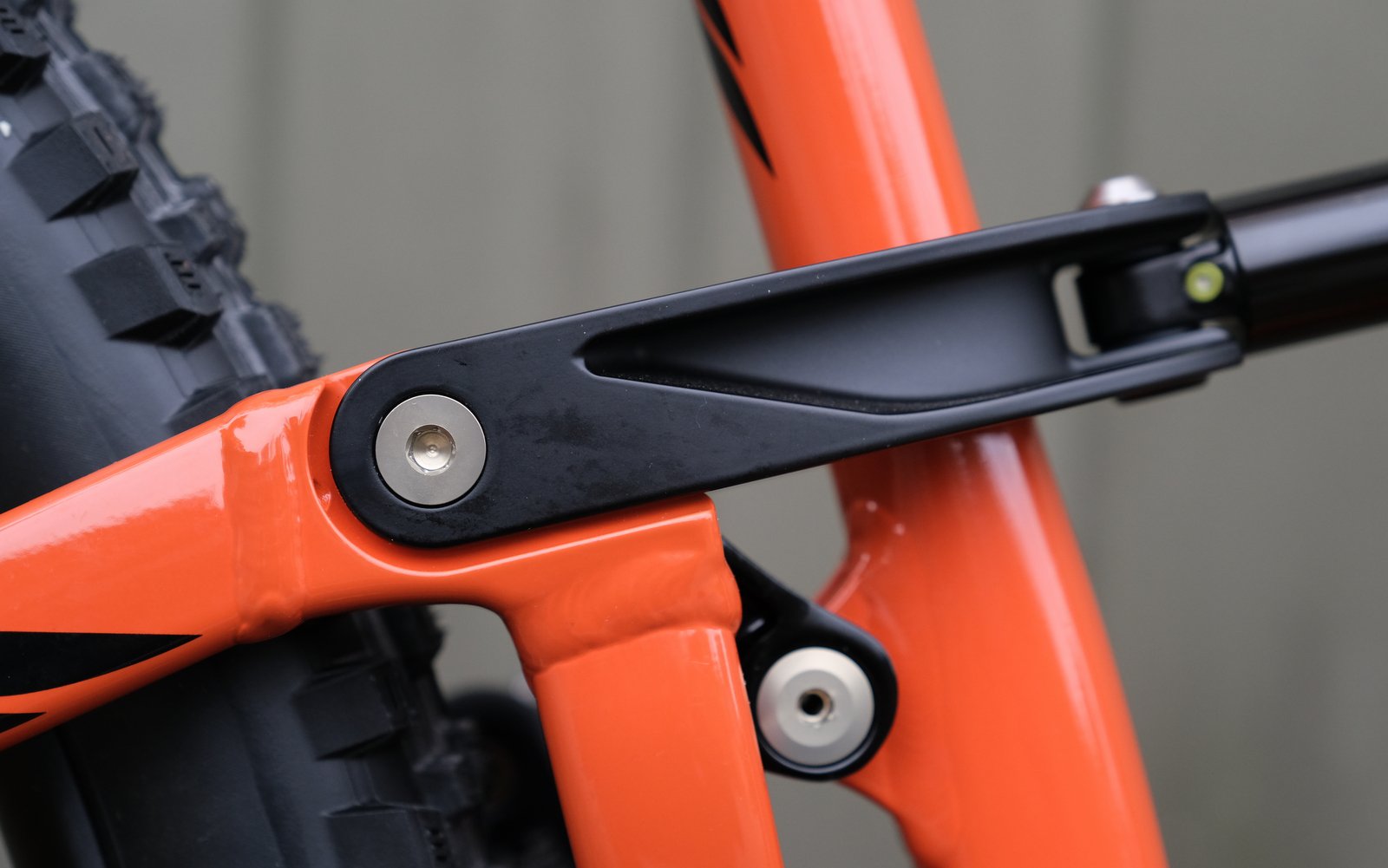
Lots going on here.
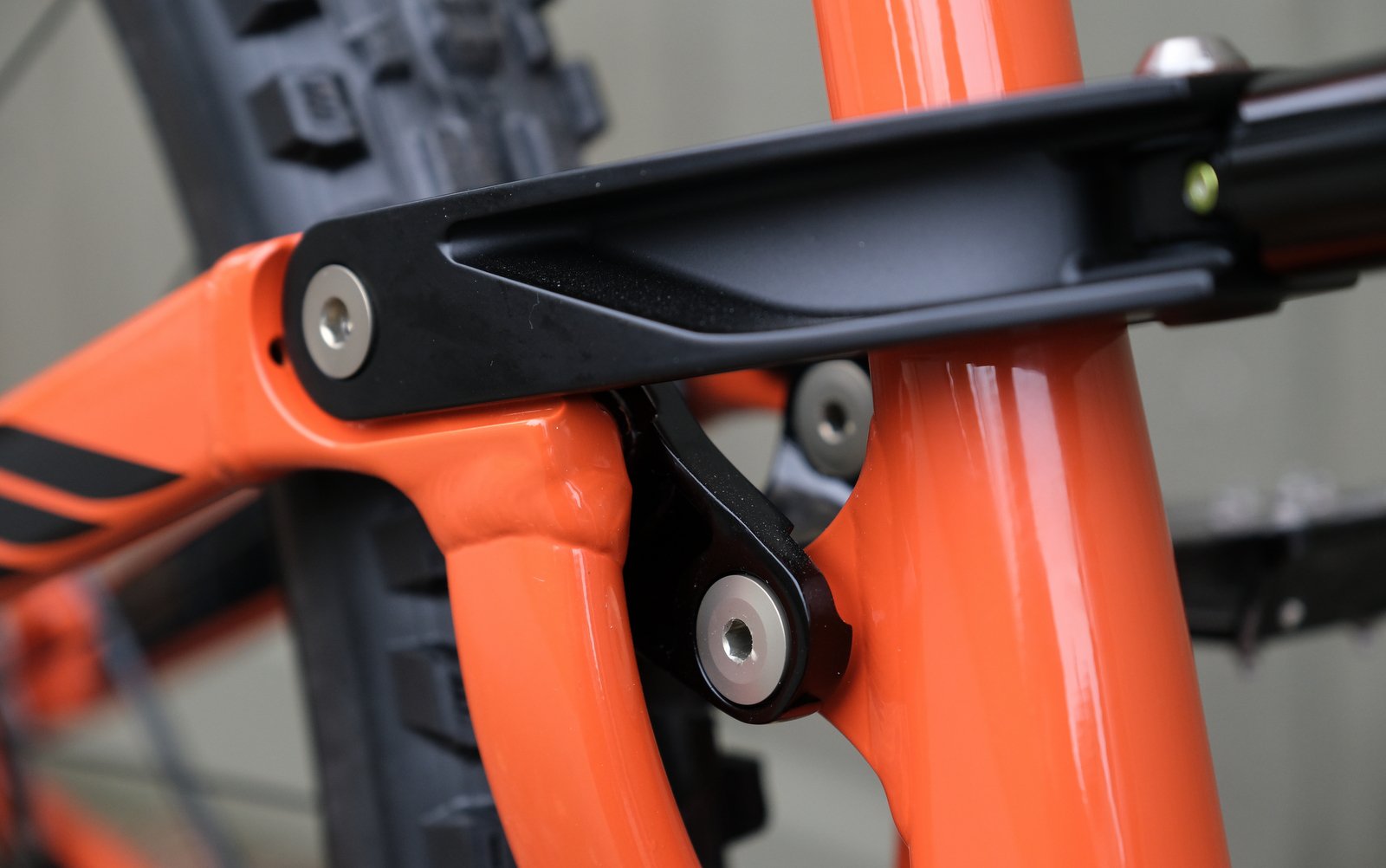
It starts to show from this angle a bit more...
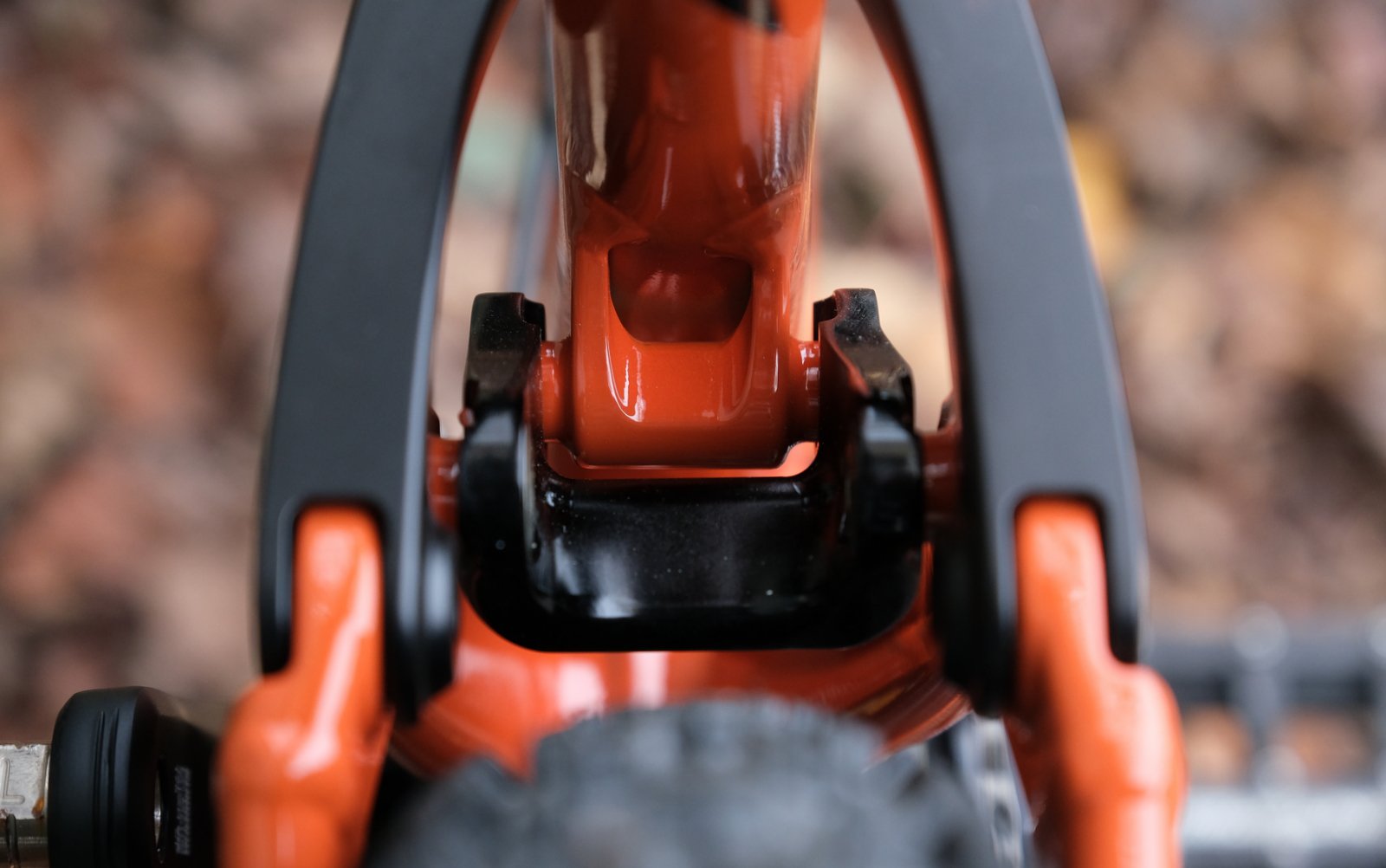
From the top, you can see that there's a fair amount of complexity to the upper link.
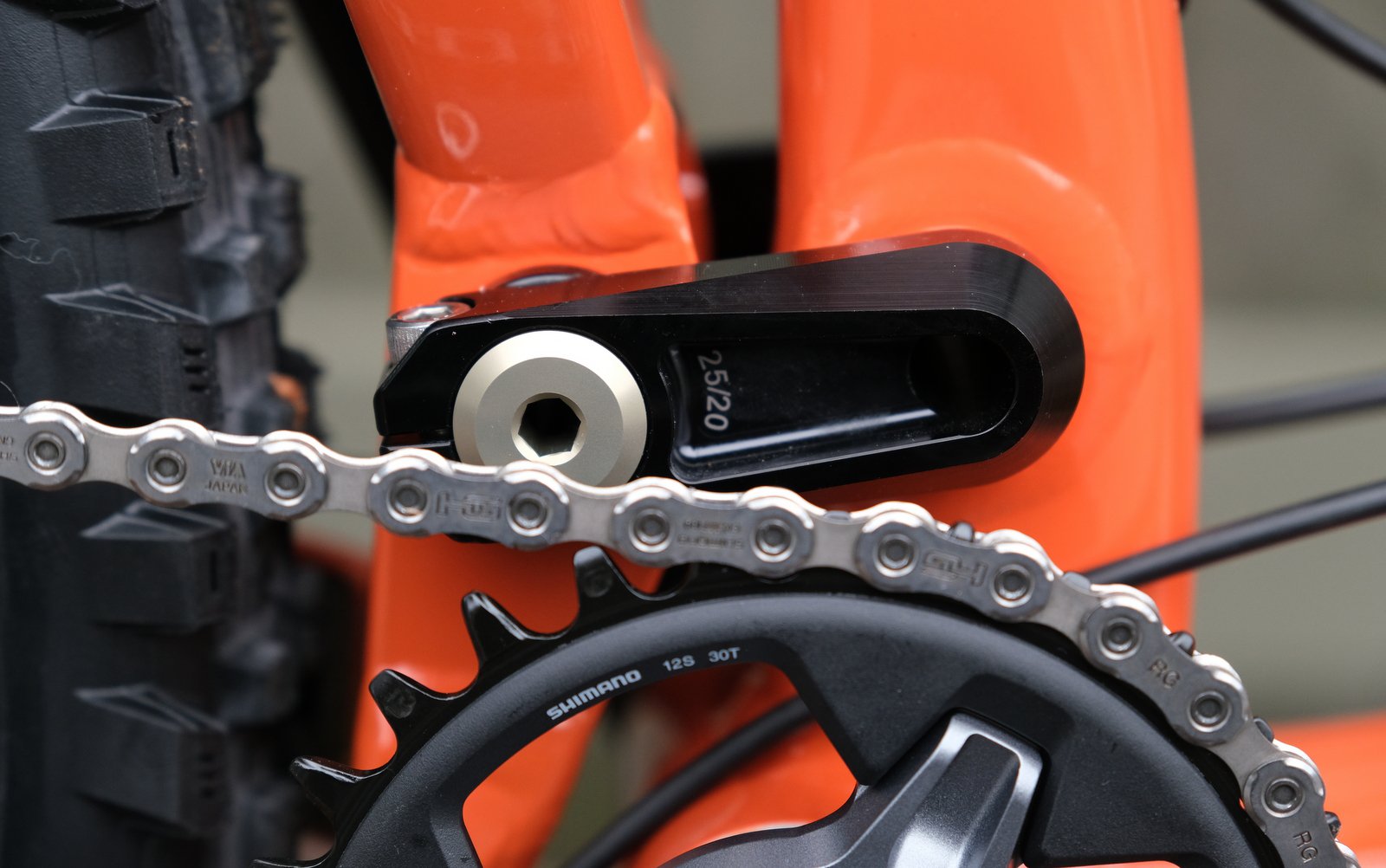
The lower link pivots on bushings.
First Rides on the Ibis Ripmo AF
A question was implied in the first section of this article. Does the Ripmo AF ride like a longer travel Ripley? It would be very easy just to say "yes" and leave it at that, but it's not quite so simple.
Getting to the obvious points, you do notice the weight. I'm not generally one to care much about weight, but it's pretty hard not to notice the lack of it on the carbon-framed, carbon-wheeled, XTR-clad Ripley. That thing is a light bike and it is very apparent under many different riding situations. So, the Ripmo AF does carry more weight, but much of the fantastic climbing capabilities of the Ripley remain.
As well, one can tell that the two bikes were born in the same place once you start coming down the hill. While there is only ~30mm more travel front and rear, the Ripmo AF does a significantly better job of eating up bumps and leaving my body intact at the bottom of the trail. It might not have crossed the threshold into "plush," and I certainly wouldn't sneeze at a bit more bottom out resistance, but it all combines into a rear end that feels pretty good, and seems to be more than the sum of its parts compared to the Ripley.
There does seem to be a trade-off, though. I feel like I'm missing some of the precision of the Ripley. On the right trail, the Ripley will pop and carve from turn to turn, holding exactly the line you have chosen down to the millimeter. It's not like the Ripmo AF is vague or anything like that, but it has traded some precision for forgiveness. This is a trade that I'll take 9 times out of 10, but it makes me wonder what a Ripmo spec'd similarly to the Ripley (XTR, Carbon frame and wheels) would feel like. Maybe that's part 3?
Overall, the Ripmo AF and I are getting along quite well. We took a few rides to get acquainted with one another, and I'm still a bit worried about some of the things that he does in the bathroom when I head off to work, but it feels like this relationship might work out well. Check back in over the next few months and find out.
Dave
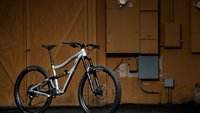

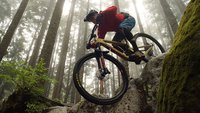
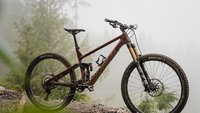







Comments
Kenny
3 years, 4 months ago
Cool. I've had my ripmo AF for about 14 months now.
I agree with your assessment so far-
It pedals well but as a heavy bike with a 2100g wheel set and 1100g tires, it prefers momentum over regaining speed by sprinting.
I swapped the topaz out for a super deluxe ultimate, the fact that the topaz effectively has no damping adjustment drove me crazy (open is wide open and mid was too firm to be usable on real trails).
I run 4.5 spacers in the shock, like you say, because of where the ramp up is in the curve, I don't find it rides like it is particularly progressive.
I also find the bike feels... wierd with less than about 33% sag, more sag seems better, it never seems to wallow much, only limiting factor is BB height.
I think it's a true all mountain bike. You can really send it up or down pretty much anything.
I guess the grass is always greener but as much as I do like feeling like I have a bike that's ready for anything, I do sometimes miss the sprint-out-corners, pick-it-up-andtossit-around feeling that a sub 30lb 27.5 bike gives you.
The big 29ers start to feel more like human powered dirt bikes (no, I don't mean ebikes) than bicycles to me and I don't know if that's a good thing...
Reply
Mammal
3 years, 4 months ago
Interesting take. I've had mine for 10 months now, and really like it. I'm a relatively light rider (165lbs) and the gravity tune on the Topaz really works for me. A lot of heavier folks on the forums have a harder time with the damping tune, but with the spacers at 0 neg/3 pos, I love the Topaz. The bike really works well with less damping back there. I agree that one might find it a bit less precise than a Ripley, but what I really love about the Ripmo characteristics is how poppy it is when you bump off of stuff. It's quite lively, but can also plow at the same time. The Diamond came on the front of mine, and it's a good fork. Probably the most tunable fork that one could hope for on a base model bike.
The newer base model spec is way better than when I bought mine. I'm not complaining, as I bought mine RIGHT before the world/industry was affected by Covid, but it was the NX version (prior ot Deore launch). Within 4 months I had an SLX deraileur/cassette/driver and Saint brakes, and I would have been absolutely stoked on the full Deore kit that's been arriving on back-logged RAF's lately.
Reply
Timer
3 years, 4 months ago
I have a Topaz on a different bike and found the bladder pressure to be the equivalent of damping adjustment. But the adjustment range might be too small for certain frame/rider combinations. It is fine for me, being light, and my frame, though.
Reply
Dave Tolnai
3 years, 4 months ago
@Timer - I haven't noticed that much difference with increasing the bladder pressure, but I will play with a bit more over the course of the review.
@Kenny - I agree on the sag. I would increase my pressure a bit, but the bike doesn't feel as good somehow when you do that. It might just put you too far down on the progressive portion of the curve or something.
@Mammal - I also think there is something to the lighter tune/heavier rider combination. That may be a conclusion that gets drawn at some point, but I'm not quite there yet.
Reply
Sean Chee
3 years, 4 months ago
Whilst it does look larger than it is, I do quite like the clean profile of the bike.
Reply
[user profile deleted]
3 years, 4 months ago
This comment has been removed.
Pnwpedal
3 years, 4 months ago
I was very close to buying a Ripmo AF, but the weight weenie in me held back. I noticed you forgot to list the weight @Dave Tolnai, IIRC an XL is something like 35-36lb without pedals. Then I decided to stick with 27.5" tires so I bought a Mojo HD5 which has been perfect. I'm definitely an Ibis fan, it's a great brand with great people. The newest bikes (Ripmo AF, HD5, etc) had their suspension designed and tuned with Motion Instruments technology and it definitely shows in the lively, playful feel.
Reply
Mammal
3 years, 4 months ago
The RAF frame is 2lbs heavier than the carbon version.
Reply
Pnwpedal
3 years, 4 months ago
Yep, and the build spec is also a bit heavier for the AF builds. Last I checked a Medium AF was 34.5lb-ish with the lighter GX build. SLX adds a bit as well.
Reply
Mammal
3 years, 4 months ago
The Diamond/Onyx is what pushes the RAF spec a bit heavier. The forks are heavier, while the rear shock is lighter (but to a lesser degree). Aside from XT available on the carbon, 2021 parts specs are identical.
Reply
Pnwpedal
3 years, 4 months ago
True, and the RAF GX does get the carbon handlebar too.
Reply
Dave Tolnai
3 years, 4 months ago
I haven't included a weight in a review since...gosh...I think I did it once! I need to get a weight on the Norco Shore, so we'll see if I get around to this one as well.
Reply
Pnwpedal
3 years, 4 months ago
Discussing modern bike weight could actually make for a good article. With "Enduro" bikes getting heavier and the lines blurring between trail/AM/freeride bikes there are definitely diverging schools of thought on weight. And once you add water bottle/cage, tools, pump, tube, etc onto a 35-36lb bike you're pushing 40lb. Many people don't see an issue with that. The irony is that I'm considered a weight weenie now because I want to keep my bike as close to 30lb as possible (well as close as my wallet allows). So I'll gladly rock a hip/fanny pack and put things in my pockets.
Some claim that "weight is weight" but I definitely feel the difference in handling by a 1-2lb difference on my bike when I'm having fun on it. Maybe it doesn't matter while slogging up a logging road, I can see that point.
Reply
Dave Tolnai
3 years, 4 months ago
Somebody should do some science on bike weight vs. rider weight.
Reply
Saris Mercanti
3 years, 4 months ago
Hi, I work for Ibis. I don't have a weight for an XL, but a size large NX build with DVO air suspension , 2.5" Assegai EXO + tires and sealant, weighs 32.5 lbs without pedals. With pedals, it sits around 33.5 lbs. That's on par with some carbon fiber bikes in the same category.
You'd have to throw on DD tires and a coil shock to push the weight upto 35-36 lbs.
The Ripmo and Ripmo AF kits we currently offer are identical, right down to the suspension. The only difference is that our highest price AF build kit is GX. We don't offer an AF with XT or XX1. We just haven't had any demand for those higher price points on aluminum.
Reply
Johannes Schmidt
3 years, 4 months ago
Availability of spare parts is one thing, pricing is another...
f.ex. 100$ for these parts
https://dvosuspension.com/product/topaz-damper-body/
https://dvosuspension.com/product/axle/
Glad that I'm still within the warranty period with my current ratio of 1 rebuild every 1-2months of usage of my Topaz
Reply
Grilledcheesetriple
2 years, 9 months ago
How does it compare/differ to/and from the Norco Sight in regards to riding characteristics and which is best or better at what?
Reply
Please log in to leave a comment.